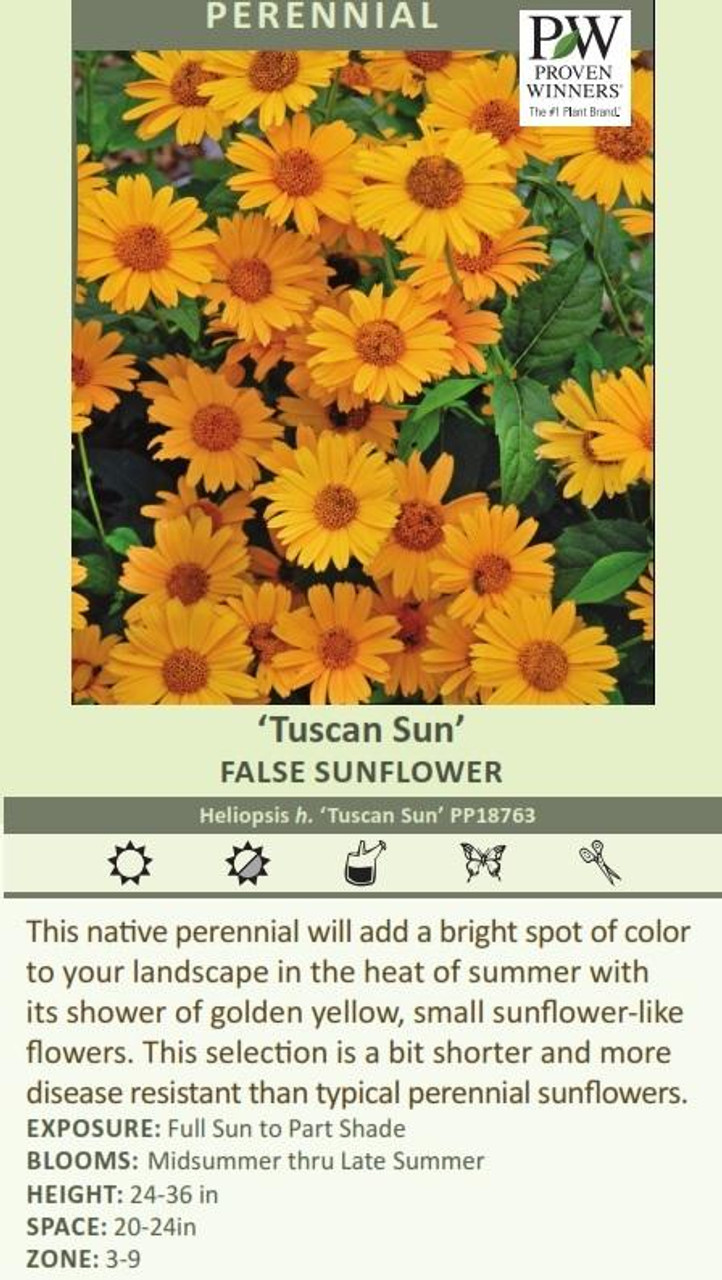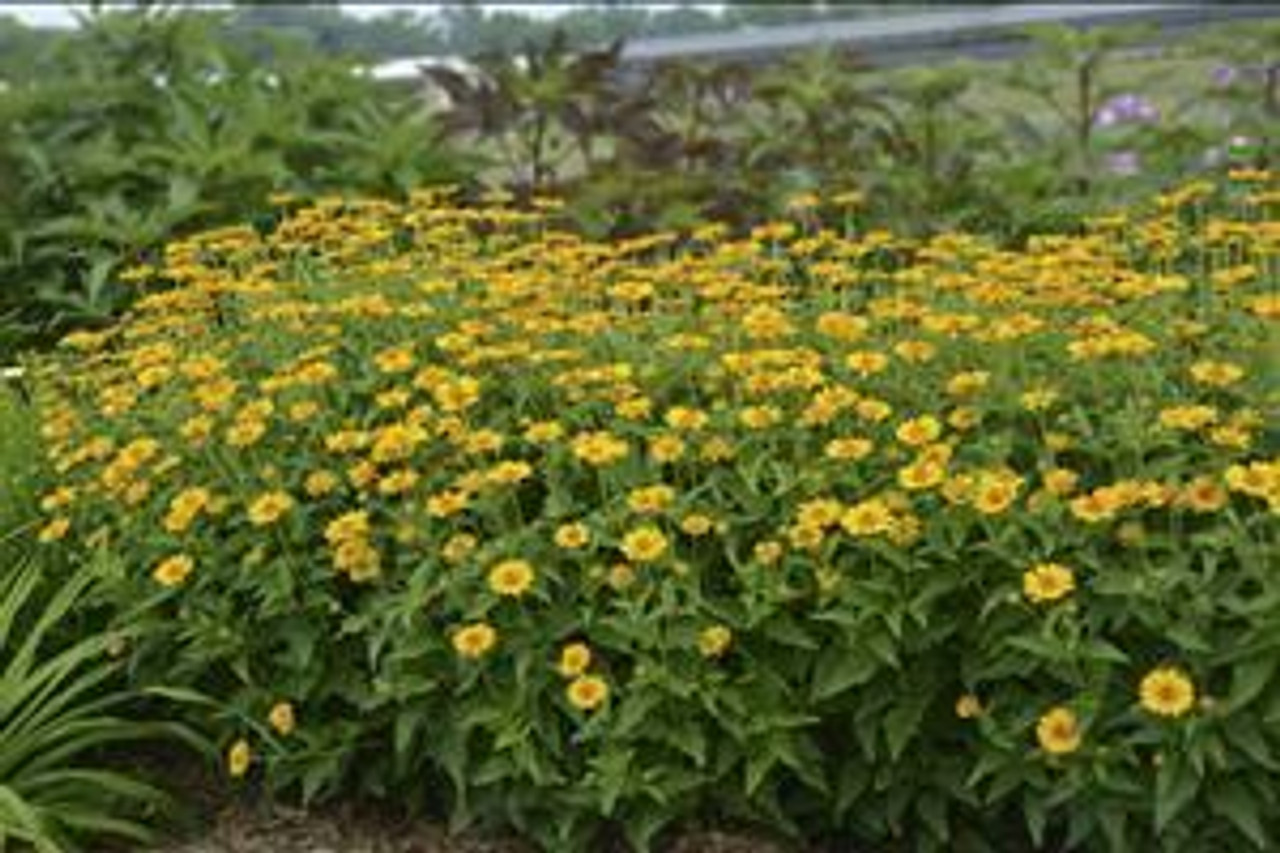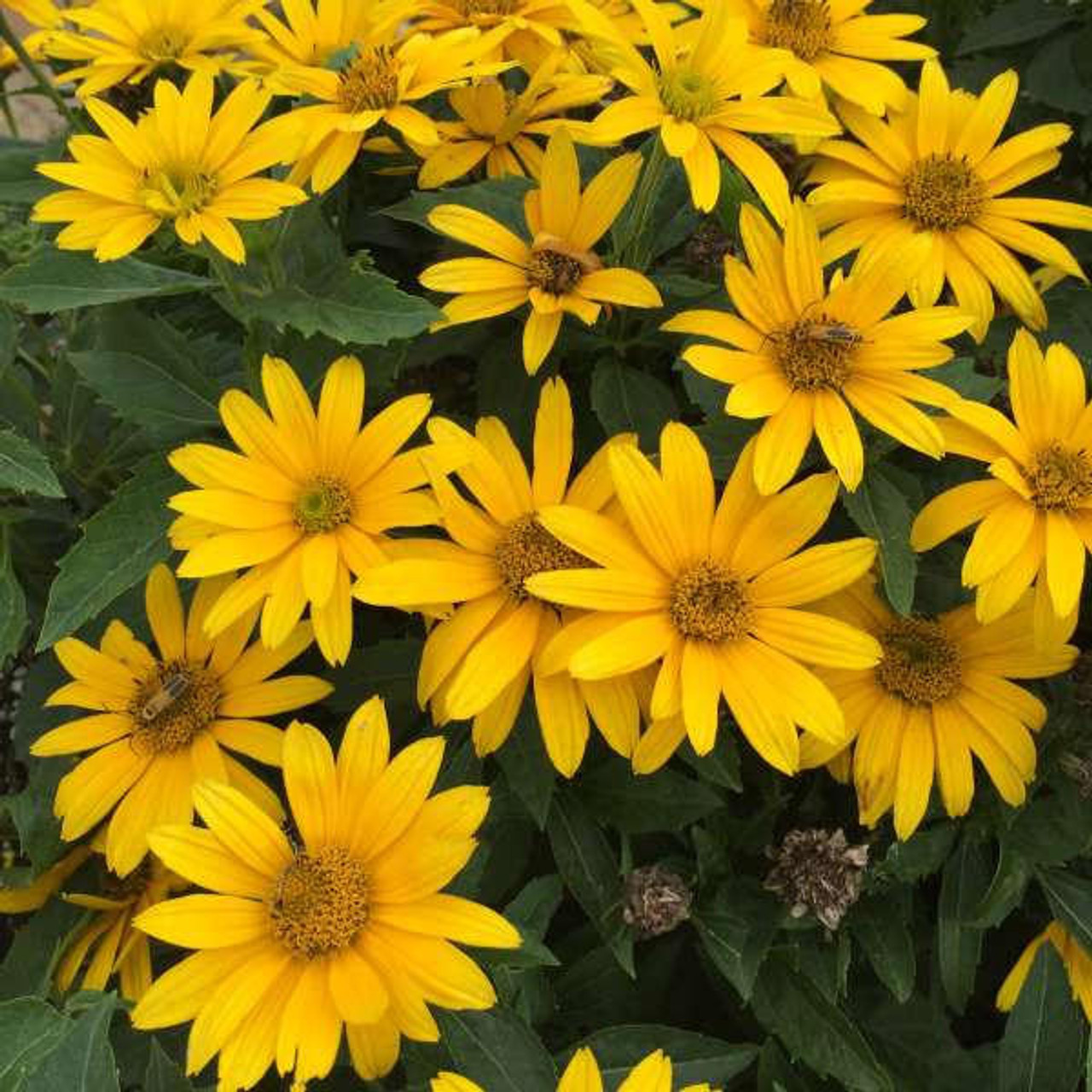Product Description
Heliopsis helianthoides 'Tuscan Sun' PP18763 (25) Bare Root Plants
Common Name: False Sunflower, Sunflower Heliopsis
This beautiful and carefree native cultivar offers a more compact habit and good disease resistance compared to other varieties of Heliopsis.
Bright golden yellow, daisy-like flowers with an orange-gold button center are produced on strong stems from mid through late summer atop the deep green foliage. It provides a brilliant beacon of color in the landscape during the hottest months of summer. Be sure to plant a few extra for your fresh bouquets!
Heliopsis have traditionally been an excellent tall perennial for the middle or back of the flower border. It has a bushy, well-branched form and glossy, deep green, triangular leaves – a real workhorse in the garden! Use this plant in combination containers, as a cut flower, or to attract butterflies to your garden.
Heliopsis can be grown in either full sun or part shade, but it performs much better in full sun. Soil of average fertility is preferable. When grown in moist, rich soil, it tends to need staking. Growth will be strongest in soil with average fertility and moisture.
Deadheading spent flower heads will extend the flowering time and prevent self-seeding.
Height: 24.0-32.0 Inches
Spread: 20.0-24.0 Inches
Hardiness Zones: 4,5,6,7,8,9
Flower Color: Yellow Shades
Foliage Color: Green shades
Full Sun (> 6 hrs. Direct Sun) - Part Shade (4-6 hrs. Direct Sun)
Average Water Needs
Average Soil Quality
Bloomtime: Midsummer - Late Summer
Attracts Butterflies
Bee Friendly
Growth Rate: Medium
Border Plant, Cut Flower, Cut Foliage, Mass Planting, Focal Point, Native to North America
Heliopsis helianthoides 'Tuscan Sun' is a compact, herbaceous perennial that brightens any garden with its cheerful golden-yellow flowers. It is a cultivar of the oxeye sunflower, also known as false sunflower, and is native to eastern and central North America. This sun-loving plant is a favorite among gardeners for its long blooming season, low-maintenance nature, and ability to attract pollinators.
'Tuscan Sun' is a standout due to its compact growth habit, typically reaching a height of 15 to 20 inches and a spread of 0.75 to 1 foot. This makes it a versatile choice for smaller gardens, borders, and containers. It was developed as a seedling in a breeding program initiated in 1997 in Rhinelander, Wisconsin. The compact growth habit of 'Tuscan Sun' offers new versatility, allowing heliopsis to be used in confined garden beds and containers. This Proven Winner plant boasts an abundance of daisy-like flower heads, each with a single row of golden-yellow ray florets surrounding an orange-gold center. The flowers bloom profusely from June to September, providing a long-lasting display of color. The dark green foliage provides an attractive backdrop for the vibrant blooms and remains attractive throughout the growing season. The leaves are ovate, toothed, and have a somewhat sandpapery texture. The upper leaf surface is a darker green, while the lower surface is slightly lighter.
Care Requirements 'Tuscan Sun' thrives in full sun and well-drained soil. It is an easy-to-grow and low-maintenance plant. Here are some key care requirements:
- Sunlight: Plant in full sun for optimal growth and flowering. It can tolerate some shade, but flowering may be reduced.
- Soil: 'Tuscan Sun' prefers well-drained soil but tolerates various types of soil, including clay, loam, and sandy soil.
- Water: Water regularly during the first year after planting to help establish a deep root system. Once established, it is fairly drought-tolerant.
- Fertilizer: It generally does not require heavy fertilization. A light application of a balanced fertilizer in spring can be beneficial.
- Deadheading: Remove faded flowers regularly to encourage more blooms and prevent self-seeding.
Uses in the Landscape 'Tuscan Sun' is a versatile plant that can be used in various garden settings. Its compact size makes it ideal for smaller gardens, borders, and containers. It can be used as a mass planting to create a bold statement or as an accent plant to add a pop of color. 'Tuscan Sun' is also a great choice for pollinator gardens, as it attracts butterflies and bees.
Companion Plants 'Tuscan Sun' pairs well with a variety of other perennials. Some suitable companion plants include:
- Agastache
- Amsonia
- Asters
- Baptisia
- Heuchera
- Phlox paniculata
- Physostegia
- Tradescantia
- Veronicastrum
- Nepeta
- Salvia nemorosa
- Geranium 'Rozanne'
Potential Problems While generally a low-maintenance plant, 'Tuscan Sun' can be susceptible to aphids. Monitor the plant for pests and take action if necessary.
Hardiness Zones This cultivar is adapted to USDA Plant Hardiness Zones 3 to 9. This wide range of adaptability makes it a suitable choice for various climates across the United States.
Heliopsis h. 'Tuscan Sun' is a delightful and versatile addition to any garden. Its compact size, vibrant golden-yellow flowers, and long blooming season make it a favorite among gardeners. This Proven Winner cultivar is low-maintenance, drought-tolerant, and adaptable to a wide range of growing conditions. 'Tuscan Sun' is an excellent choice for borders, containers, mass plantings, and pollinator gardens. Its ability to attract butterflies and bees makes it a great option for environmentally conscious gardeners who want to support local ecosystems. With its cheerful blooms and reliable performance, 'Tuscan Sun' is sure to bring a touch of sunshine to any outdoor space.
Other Details
The most important part of the plant is its root system. Healthy roots are the foundation of a healthy, vibrant plant. The type of plug container used is based on the specific needs of the plants. Perennials offered as bare root traditionally perform better when planted as bare root.Planted in a specialized mix, potted plants have well established root systems. Top growth stage will vary depending on the current life cycle and time of year when shipped. In Winter and early Spring dormant plants may be shipped. Dormant plants may be planted right away, even before the last frost date.
Most bare root varieties are field grown for at least one season, though Hemerocallis and Hosta are grown for two seasons. The bulk of the soil is removed during the harvesting process and the tops of most varieties are trimmed back to the crown. They are graded, packed in shredded aspen or sphagnum moss and stored in freezers until ready to be shipped.
See our Container Sizes and Bare Root Perennials pages for more information.
Plant information and care is provided in the Overview section, Plant Genus Page and general information is provided in the Planting Care & Guides. Additional questions can be asked on each Plant page.
Plant Spacing: Using the maximum mature spread or width of a plant to guide spacing, ensures space to grow to full size. To fill an area sooner, plant them closer together. Just remember, future thinning or transplanting may be needed.
Water: Keep a close eye on newly planted perennials, especially throughout the first growing year. Most early plant loss is due to too much or too little water!



















